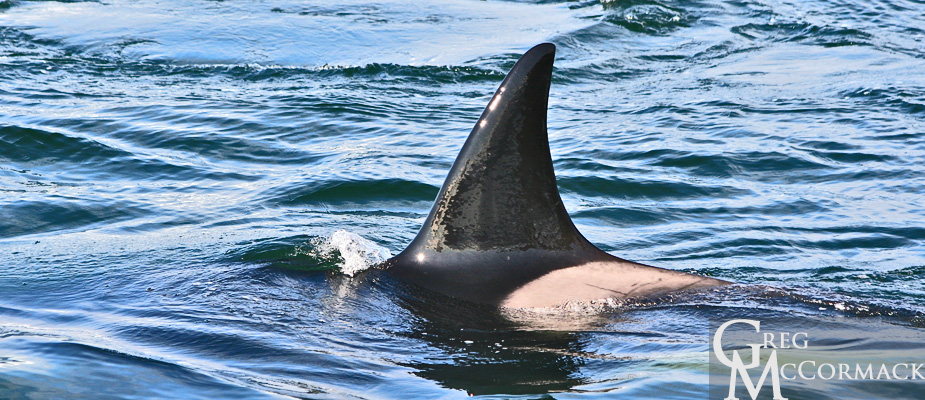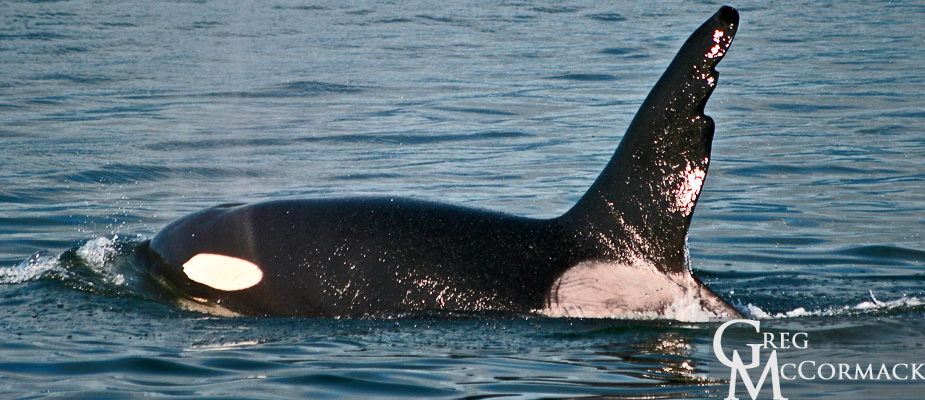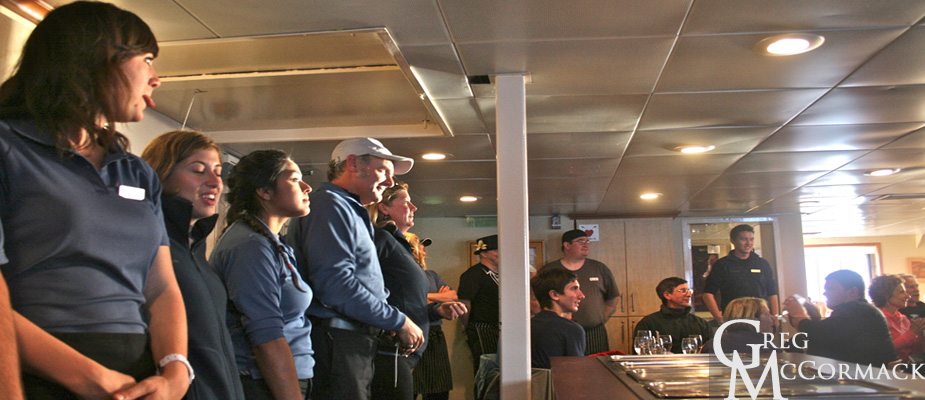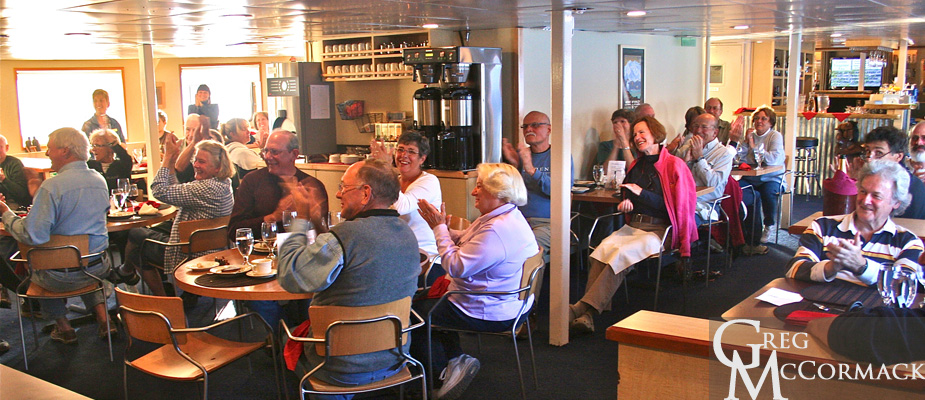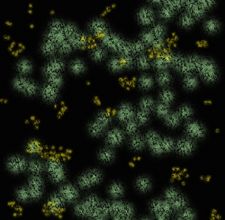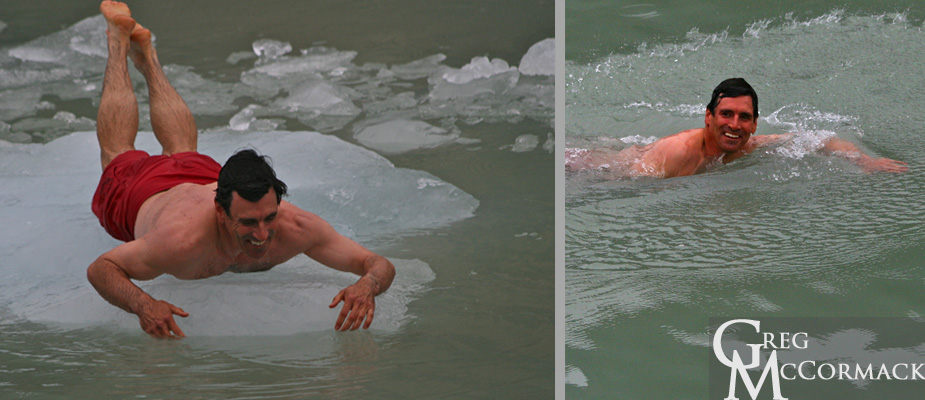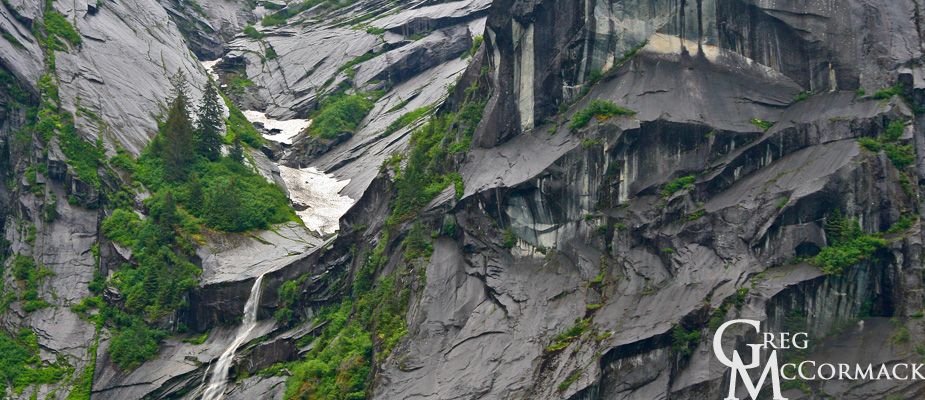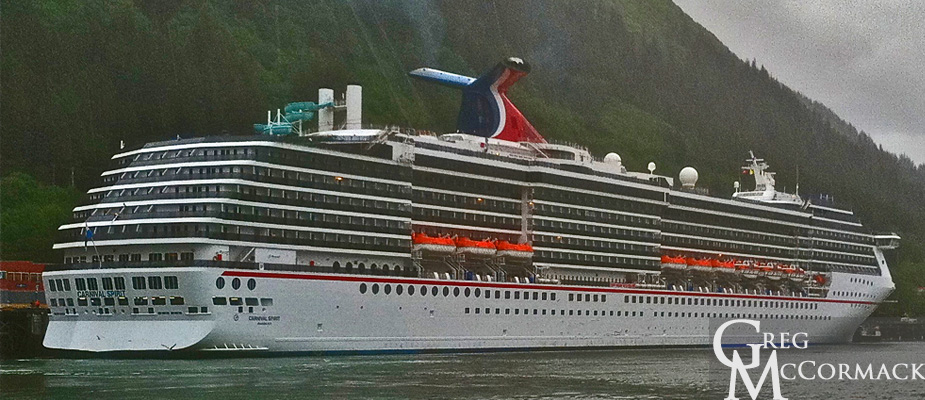Search results
Friday | July 15
September 26, 2011 by admin
Filed under InnerSea Discoveries
Endicott Arm & Dawes Glacier
“The earth, that is sufficient
I do not want the constellations any nearer,
I know they are very well where they are,
I know they suffice for those who belong to them.”
–Walt Whitman, Leaves of Grass, “Song of the Open Road” (1855)
We lift anchor at 0500 at Wood Spit and enter Holkham Bay, the outlet of both the Tracy and Endicott Arm fiords. We take the route up the Endicott in a thick fog. I assure guests that we should see a clearing close to the glaciers. High pressure is usual near the icefield surrounding the peaks of the Coast Range.
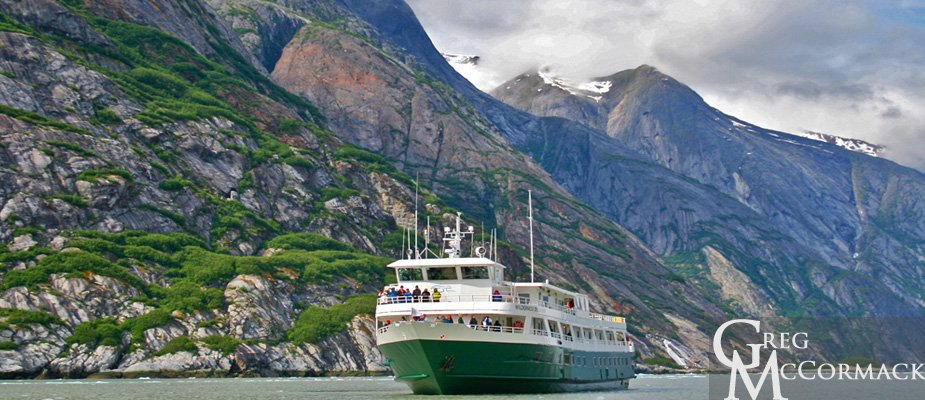
The cold, heavy air sinks down and pushes away the Low Pressure system from the face of the tidewater glacier. As soon as we get within a couple of miles, the fog lifts and we see blue skies and sunshine!
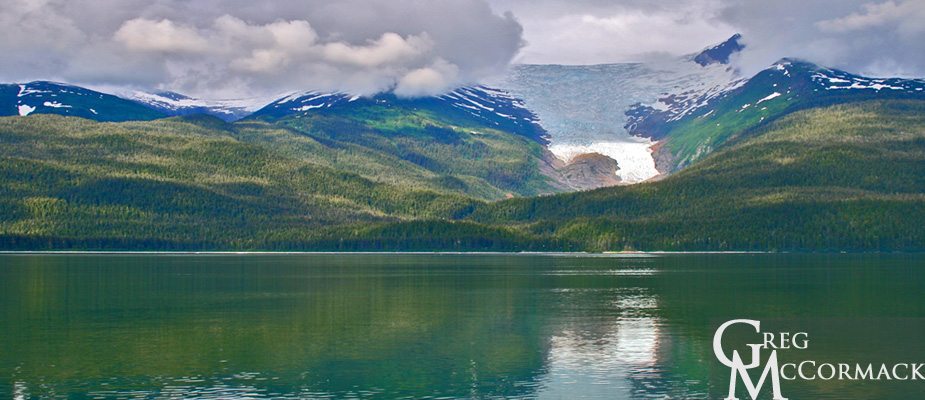
Very little brash ice is seen…mainly growlers with only a few bergy bits and ice-bergs near the spectacular Dawes Glacier. We disembark for small boat tours and stop about ¼-mile away from the 200-foot face of the tidewater glacier. Several small calvings produce the surprisingly loud “white thunder”. The Tlingit Indians had a tribe named after the sound made by the dropping of ice: Sumdum.
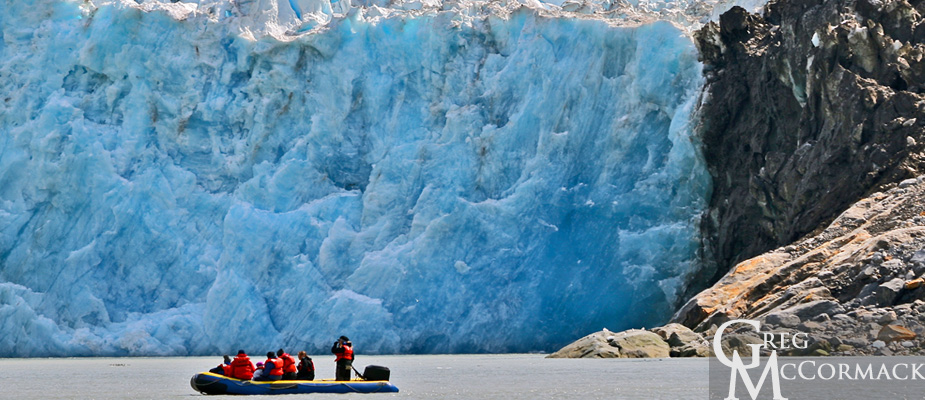
We enjoy seeing Arctic Terns diving down for small fish or resting on growlers. Seals were seen frolicking in the white-water of cascading waterfalls.
Two Tongass National Forest Service wilderness kayak rangers paddle over and come aboard for answering questions. Kevin Hood talks about the history of the Wilderness Act and answered questions about harbor seal census counts.
The most amazing thing Ranger Hood shared during his excellent talk was the 2009-2010 studies of the Dawes Glacier. Laser altimetry showed that the Dawes Glacier had thinned or deflated 70 meters in one year, making it one of the fastest wastage and melting areas in the world. Change is happening at a dramatic pace here in the 100-mile long Stikine Icefield!
After dropping the kayaks and the rangers off of our swim-step aft of the vessel, we search hard along the shoreline for four-legged furry animals. We see hundreds of Surf Scoters, otherwise known as the “poor-mans’ puffin” for the similar appearance to the Tufted Puffin. The latter is typically found nesting on protected islands closer to the Gulf of Alaska or in Glacier Bay National Park and Preserve. On the north shoreline, we see the beautiful blooms of the fireweed.
Outside of the Endicott Arm in Stephens Passage, we are lucky to find a pod of killer whales.
We are happy to see many kinds of behavior such as spy-hopping, lob-tailing and breaching.
A young orca was seen surfacing next to its mother.
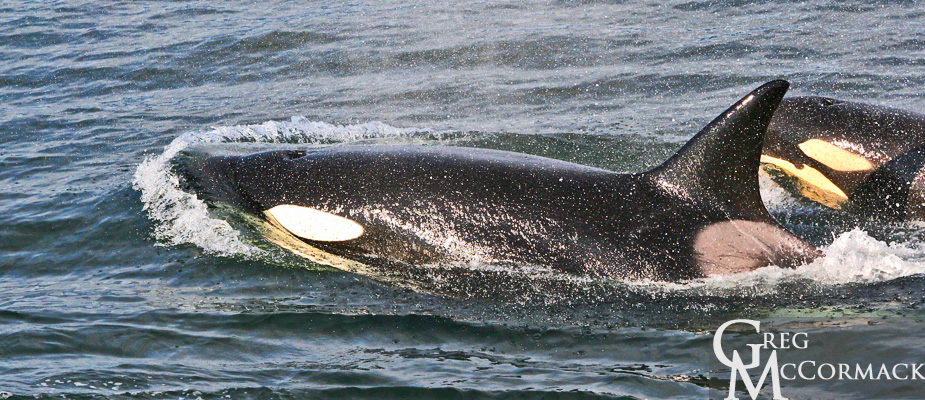
We suspect these orcas are residents as it looks like they are surrounding and echo-locating for fish. We watch them for quite some time as they happen to be swimming north at the same slow pace that we are motoring.
Anchorage for this evening is just outside of the Taku Inlet. It is the Captains’ Dinner tonight and Marce introduces all of the crew to the rousing applause of our friendly guests.
A bit of sadness is felt as it was time to pack suitcases after a slide show presentation in the lounge shows all of the highlights over the last week of cruising.
is bustling this morning as we dock alongside the pier adjacent to large cruise ships and a float plane dock
A local tells me that the recent U.S. Census had between 5 and 6,000 people moving out of the capital city of Juneau, a drop from around 31,000 to 25k over the last 10 years.
Crew work hard in anticipation of another group that will board in less than 8 hours.
Saturday | July 2
September 14, 2011 by admin
Filed under InnerSea Discoveries
“If there is magic on this planet, it is contained in water.” –Loren Eisely
The M/V Wilderness Discoverer lifts anchor and motors north through Gastineau Channel and docks beneath the rising peaks of Mount Roberts and Mount Juneau. All (departing passenger) luggage is taken off of the vessel and carried up the dock ramp to the waiting buses.
A fond farewell takes place between crew and guests as the latter disembark to hug and shake hands with their favorite crew members on the dock. Great memories and sad goodbyes!
The excitement for the morning is when I crashed a fully-loaded, heavy rolling cart on the ramp leading down to the pier. Luckily none of the eggs in the 13-dozen box broke.
Note to self: Do not use a cart that lacks hand brakes when the tide is low. All of the carts but one has a hand brake. Kristen helps me re-load and we get back to transporting stores from truck to ship.
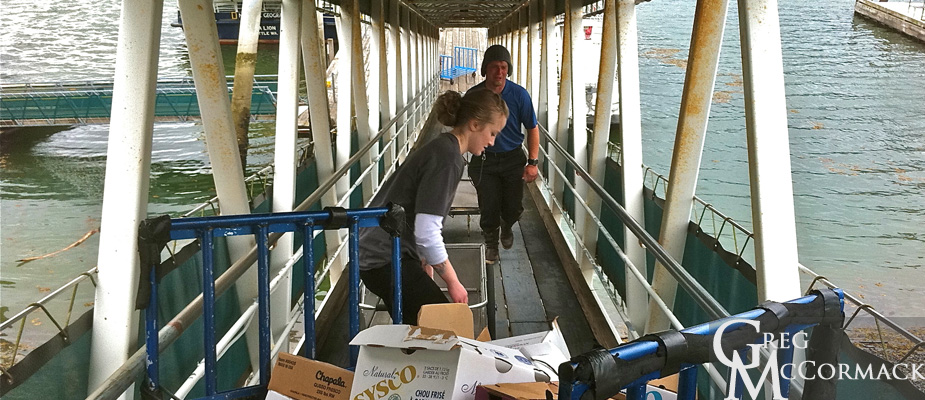
All available hands on the ships crew prepare for a new group of passengers that will board the vessel at 16:30 hours. All decks are swabbed, port holes washed, sheets changed, cabins and heads cleaned, dirty laundry and garbage hauled off ship, and galley stores stowed.
After our welcome aboard orientation meetings with the deck, engineering, hotel and expedition leads, the M/V Wilderness Discoverer pulls away from the Juneau dock and heads south in Gastineau Channel. We spot some Humpback Whales feeding just outside of the Taku Inlet and enjoy the sunset on the outside decks.
Our destination for tomorrow will be the one of three spectacular fiords in the Tracy Arm—Fords Terror Wilderness, about 46 miles south of Juneau. The area encompasses close to 700,000 acres of rugged Coast Range mountains bordering Holkham Bay, the spot where we will be anchoring tonight.
The three dramatic fiords are Endicott Arm, Fords Terror and Tracy Arm, all of which trend west-to-east through the Coast Mountain Range. The three tidewater glaciers drop down from the Stikine Icefield and regularly calve ice bergs into the ocean.
Friday | July 1st
September 10, 2011 by admin
Filed under InnerSea Discoveries
The Green Flush and an Ice Swim
Speaking of plankton, I awake and visit the head (bathroom) without turning on the light and shout “Wow” several times, loud enough to awaken my cabin-mate. I couldn’t contain my enthusiasm.
You’ve heard of the green flash? Been there, seen that. You have to see the green flush! I will have to take a picture of it next time I see it. You see, our septic system works on sea water. In just a few liters, you can have tens of thousands of microscopic organisms. On rare occasions, the entire bowl in the head is awash with a blue-green light. When the head is flushed, hundreds of miniature lights sparkle and swirl. It’s as if you are in the beginning of a Star Trek or Star Wars movie with distant stars moving quickly past the camera.
I run out of my room and start inviting my fellow shipmates over to see it, but it sure does take a lot of coaxing to get anyone interested. Perhaps it’s because the area inside our bathrooms are so small…standing in the center with your arms akimbo is all the room you have to maneuver.
What I learned years ago is that the light is caused by a luciferin-luciferace enzymatic reaction, a luminescence of a biological kind, otherwise known as bio-luminescence. If I remember correctly, the organisms that cause this are often Noctiluca, Gymnodinium, Ceratium and Gonyaulax. What’s amazing is that 80% of the organisms that live in the bathy-pelagic or deep water realm of the ocean exhibit some type of bioluminescence in order to attract mates, lure food or just communicate amongst each other.
The M/V Wilderness Discoverer motors into Endicott Arm to the Dawes Glacier. A commotion suddenly erupts at the stern of the vessel. A large group convenes near the swim step for the newest rendition of the Polar Bear Club. I grab a pair of swim trunks, and squeeze my way forward to the platform. I dive in and swim out to the nearest “growler” ice-berg. I climb up, imitate a harbor seal by laying down on the ice and look back at the ship. The water clears out of my ears and I hear all the cheering and invitations to join folks in one of the ships hot tubs. I dive back in and enjoy the sensation of the thirty-something degree Fahrenheit water.
In case you haven’t guessed, I am a pagophilic or ice-loving mammal just like the walruses, seals and whales that inhabit waters in Alaska. I may not have as much blubber, but the feeling of cold water is fabulous, like drinking 20 cups of coffee without having any jitters. A clean, invigorating sensation, for sure!
The other highlight of the day is motoring up Fords Terror, a spectacular fiord that John Muir named “Many Yosemite”.
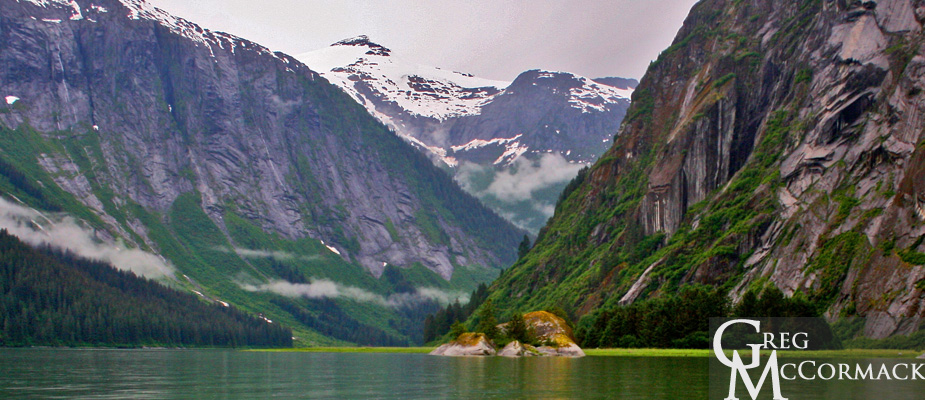
In his book “Travels in Alaska” Muir wrote: “…we found ourselves on a smooth mirror reach between granite walls of the very wildest and most exciting description, surpassing in some ways those of the far-famed Yosemite Valley. We drifted silent and awe-stricken beneath the shadows of the mighty cliffs…a grander array of rocks and waterfalls I have never yet beheld in Alaska…one of my brightest and best of all my Alaska days.”
Small boats are the best way to see so much grandeur in so short a time. Waterfalls were everywhere along with sheer cliffs and outstanding scenery. Fords Terror would be well worth a longer visit, preferably several days via sea kayak.
Saturday | June 4th
July 28, 2011 by admin
Filed under InnerSea Discoveries
Everybody is still talking about our marvelous voyage and the jaw-dropping tidewater glacier we saw yesterday in the Endicott Arm. We appreciate the value of small-ship cruising when we dock adjacent to one of the mammoth-sized cruise ships in Juneau, the capital of Alaska. While packing suitcases, guests take pictures of our maps and the wildlife list that I kept up-to-date during our week-long excursion.


